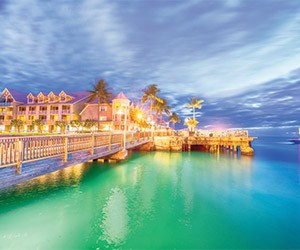Some come to play, some come to stay, but one thing is sure—anyone visiting the Florida Keys gets a temporary reprieve from reality. Curving like a comma off the southeast coast of Florida, the Keys offer their own kind of pause from the daily grind, opening a world of fishing, boating, diving and dining while preserving some of the country’s most prized historical treasures.
That’s not to say the Keys don’t have their serious side. From Key Largo to Key West, there are resort-based conference facilities and event venues large and small. But for those who want to make the great escape even greater, a detour off the Overseas Highway—the road connecting the upper, middle and lower Keys and terminating in Key West—leads to waterways less traveled and smaller islands even more removed from civilization yet brimming with amazing adventures. Following are just a few of them.
Indian Key: ‘Ghost Town’
It might be hard to imagine now, but today’s Indian Key Historic State Park was once the largest Keys community outside Key West and in 1835 boasted a general store, a hotel with a bowling alley and restaurant, a post office, warehouses and other trappings of what was then modern society. Destroyed by attacking Indians in 1840, today only the stone foundations and hints of former streets remain, though nature has taken over in a beautiful way.
“It’s really the only ghost town in the Florida Keys,” says Brad Bertelli, local historian and author, who also owns Historic Upper Keys Walking Tours (http://historicupperkeyswalkingtours.com) and leads 30- to 90-minute tours of the 11-acre island for groups of up to 30. “If you drive by on the highway, it looks like an ordinary island, but once you get out there, the history is just amazing.”
Groups can depart from Robbie’s Marina on nearby Islamorada, with kayak being the most popular choice, Bertelli says.
“If they kayak out there, I’ll kayak with them and give them a little history as we go,” he says.
Ancient Forests Breathe Life on Lignumvitae Key
As they come off the Florida peninsula, the Keys bisect the Atlantic Ocean and Florida Bay, which by the time you get to Key West, has merged into the Gulf of Mexico. Indian Key is on the Atlantic side and just across the Overseas Highway on the bay side is 280-acre Lignumvitae Key, so named because the Spanish explorers who landed there in the 1500s believed the resin of its trees had medicinal qualities and called them the “wood of life.”
Though they don’t actually give life, the lignumvitae trees here have an exceptionally long life; some are as old as 1,500 years and are part of one of the last virgin tropical hammocks that covered much of the Upper Keys before the 20th century.
An early visitor to the island was ornithologist John James Audubon, who explored it in 1832, but Miami pioneer William J. Matheson bought Lignumvitae in 1919, building a caretaker’s home with a windmill for electricity and a cistern that gathered drinking water. Today, his former home serves as the visitor center for what is now a state park, with ranger-guided tours offered twice daily from Friday to Sunday. Accessible only by private boat, groups can check out the various rental opportunities at Robbie’s Marina, also home to boat tour operators like KeyZ Charters (www.keyzcharters.com), offering excursions to Lignumvitae.
“We tour the islands by boat, looking for dolphins and other wildlife,” says KeyZ’s Captain Samantha Zeher, whose 21-foot deck boat can handle up to six passengers.
Historical Journeys on Pigeon Key
Tiny but critical to the Keys’ development, five-acre Pigeon Key was the construction camp for hundreds of workers who built Henry Flagler’s original Overseas Railway from 1908 to 1912, which later evolved into the Overseas Highway.
Once the only dot of land along the old Seven Mile Bridge, the new Seven Mile Bridge bypassed Pigeon Key in 1982 and now the island is accessed by ferry, departing three times daily from nearby Knights Key.
Groups can explore Pigeon Key’s history at eight buildings listed on the National Register of Historic Places, including the assistant bridge tender’s house, which has been converted into a railroad museum. Meanwhile, fun-in-the-sun options include snorkeling and relaxing on a private beach. Meeting space with tables, chairs and audiovisual equipment is available, or the entire solar-powered island is rentable for day and overnight events. A guesthouse sleeps eight, while larger groups can opt for bunk-style housing.
“We get all kinds of groups staying here, including corporate retreats,” says Kelly McKinnon, executive director of the Pigeon Key Foundation. “Once the tours leave for the day, it’s just your group and about 11 other people. It’s very private.”
Beach Picnics on the Out Islands of Big Pine Key
There are smaller islands flanking the Florida Keys all the way down, some no larger than a mangrove tree or two, some big enough to support a military fort, as in the Dry Tortugas west of Key West.
Keys island hopping and water adventures combine with Strike Zone Charters, whose Out Island Picnics include snorkeling, light tackle fishing and docking at a small island in Newfound Harbor near Big Pine Key in the Lower Keys, where everyone’s catch of the day is prepared during an onboard cookout.
“People can get out and explore the island if they want. There’s a small sandbar,” notes Mary Threlkeld, Strike Zone’s co-owner.
The five-hour excursion can host up to 43 passengers.
Your Own Private Island: Pretty Joe Rock and Quiet Cove Key
Privacy in the Keys isn’t hard to find, but Rent My Island on the Gulf side in Marathon takes it a step further with private homes on pristine offshore isles, including Pretty Joe Rock, where a two-bedroom home with covered deck can host up to six.
Meanwhile, you get an island plus a 38-foot houseboat that sleeps eight at Quiet Cove Key. But for larger groups, Rent My Island Owner Bob Rainek says another 20 can be easily accommodated at the same location.
“I have two waterfront homes really close to Quiet Cove Key, so larger groups will use the homes and then everyone gathers on the island,” he says.
Never mind about transportation; motorboats and kayaks are included with both rentals.






